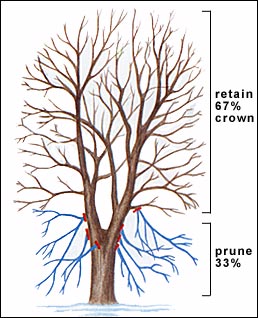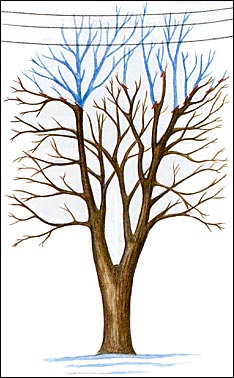Pruning The Bottom Of The Tree Crown:
Pruning the bottom area of the crown allows the free flow of vehicle and pedestrian traffic, enhances the line of site, and in the case.
Figure 19 shows the proper method of pruning the bottom area of the tree crown. Limbs shown in blue are to be removed at the spot indicated by the red line.

Figure 19 - Pruning the bottom of the tree crown
Many municipalities specify a minimum ground to crown clearance for any trees that are shading sidewalks and roadways.
It is important not to prune to much of the bottom portion of the crown. The rule of thumb is that at least 2/3 of the height of the tree should be crown.
As an example, a tree that is 30 feet high should have a crown that is 20 feet from top to bottom.
If you are pruning trees that have not reached maturity it is suggested that limbs are left, temporarily to allow the tree to create its natural form and to provide protection against sun and inclement weather. Stems and new shoots should be about 5 inches apart on the limbs. As the tree matures they can be pruned to prevent them from growing to large and at a point they should be pruned off.
Reducing The Tree Crown Size
There may come a time when the top of the crown has expanded beyond the trees available and allocated area and it becomes necessary to use "crown reduction" pruning techniques.
Figure 20 shows the proper method of crown reduction pruning. Limbs shown in blue are to be removed at the spot indicated by the red line.

Figure 20 - Crown reduction pruning
This method of pruning, often referred to as "drop catch pruning", leaves the tree with a much more natural form than just thinning the tree crown. It also alleviates the need to prune the top of the crown every year, eliminating a lot of the stress that the tree undergoes every time it is pruned.
Reducing the size of the tree crown in this manner should only be undertaken if you have no other alternatives. One of the negatives of this type of pruning is that substantial wounds.
If you face this situation, consideration should be given to removing the offending tree and replacing it with a tree that is suitable for the allocated area.
Do not use this method of crown reduction on trees that have a natural pyramid form.
